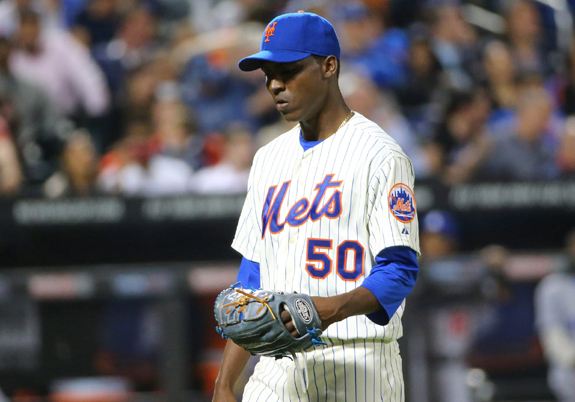
Depending on the degree to which you may follow the progress of Mets prospects in the minor leagues, from a little to intently, most people know Rafael Montero as a pitcher who throws strikes. In 2012, upon being promoted to the Mets High-A affiliate, his K% was 23.3 points higher than his BB% (K-BB% = 23.3%). The following season, his K-BB rate jumped to 23.8% in AA ball. He was striking out north of nine batters per nine innings, while walking less than two per nine. This was a guy who threw strikes.
Montero was called up to the Mets on May 14 to face the Yankees. He has only made two starts, pitching in only 10.1 innings, but a disturbing trend has developed. He is walking too many hitters.
If Montero throws strikes, why hasn’t he in his first two starts for the Mets?
Rafael Montero has thrown strikes, just not with his secondary pitches.
Montero throws four main pitch types.
- Four-seam fastball (64%)
- Two-seam fastball (5%)
- Slider (14%)
- Change-up (17%)
His four-seam fastball finds the strike zone 58.1% of the time. For comparison, Bartolo Colon, who has the second highest overall zone % in baseball, throws his fastball in the strike zone 61.6% of the time. In other words, Montero is having no problem getting his fastball over for strikes. Where the problem lies is with his secondary pitches. None of his slider, change-up, or two-seam fastball find the zone more than 27% of the time. He has four pitches. Three of them he throws for strikes less than half as much as his four-seam fastball.
Perhaps his biggest concern is with his change-up. While his slider doesn’t find the strike zone often, he throws it mostly to right-handed hitters, as the pitch darts down and away, and often times, 14.7%, gets them to swing and miss. His change-up is a concern because he is only throwing it in the zone 12% of the time, and not getting hitters to chase it like his slider. It is not a “chase” pitch, so really, he is just missing his targets.
Is his change-up the reason for Montero’s control problems so far?
As I mentioned before, Montero needs to get more than just his four-seam fastball over for strikes. That being said, his change-up has been the most fatal deviator. Montero uses his change-up almost exclusively to left-handed hitters. Like his slider to righties, his change darts down and away, but to lefties. Perhaps darts isn’t the best verb since the movement is less pronounced than his slider, but you get the point.
We can see in the heat map that all of Montero’s change-ups end up in the bottom left area of the chart. Remember, this zone profile is from the catcher’s perspective, so the red areas represent down and away to a left-handed hitter. What we can clearly see is that the majority, in fact, all except two, of Montero’s change-ups have fallen out of the traditional strike zone. He may get some help on a few calls from the umpire, but he is missing the zone far too often.
Again, is his change-up the reason for his control problems so far?
What is interesting about Montero’s first two starts is that he has faced a fairly equal number of lefties (26) as righties (23). That makes comparing his performance against the handedness of batters more meaningful.
Overall, Montero’s BB% is 12.2% in his first two starts. Against righties, it is 8.7%. Against lefties, it nearly doubles to 15.4%. The reason being that against righties, he uses his slider, and while missing the strike zone, gets them to chase. Against lefties, he relies on his change-up, which opposing batters are less likely to chase, and consequently, end up as balls.
What does it all mean?
Rafael Montero has pitched in 10.1 big league innings. It is impossible to draw any real conclusions off such a small sample size. There has to be some concern that a trend has developed along with his climb through the minor leagues. He has seen his overall BB% climb from 3.8% (AA) in 2013, to 6.9% (AAA) in 2013, to 10.6% (AAA) in 2014, before being called up to the majors, where the trend continues. There isn’t data available to see how his change-up performed in the minors, but we know from his first two starts with the Mets, that it is a pitch he is having trouble throwing for strikes. And it is at least something to look out for as we watch him develop.
Statistics courtesy of FanGraphs.















